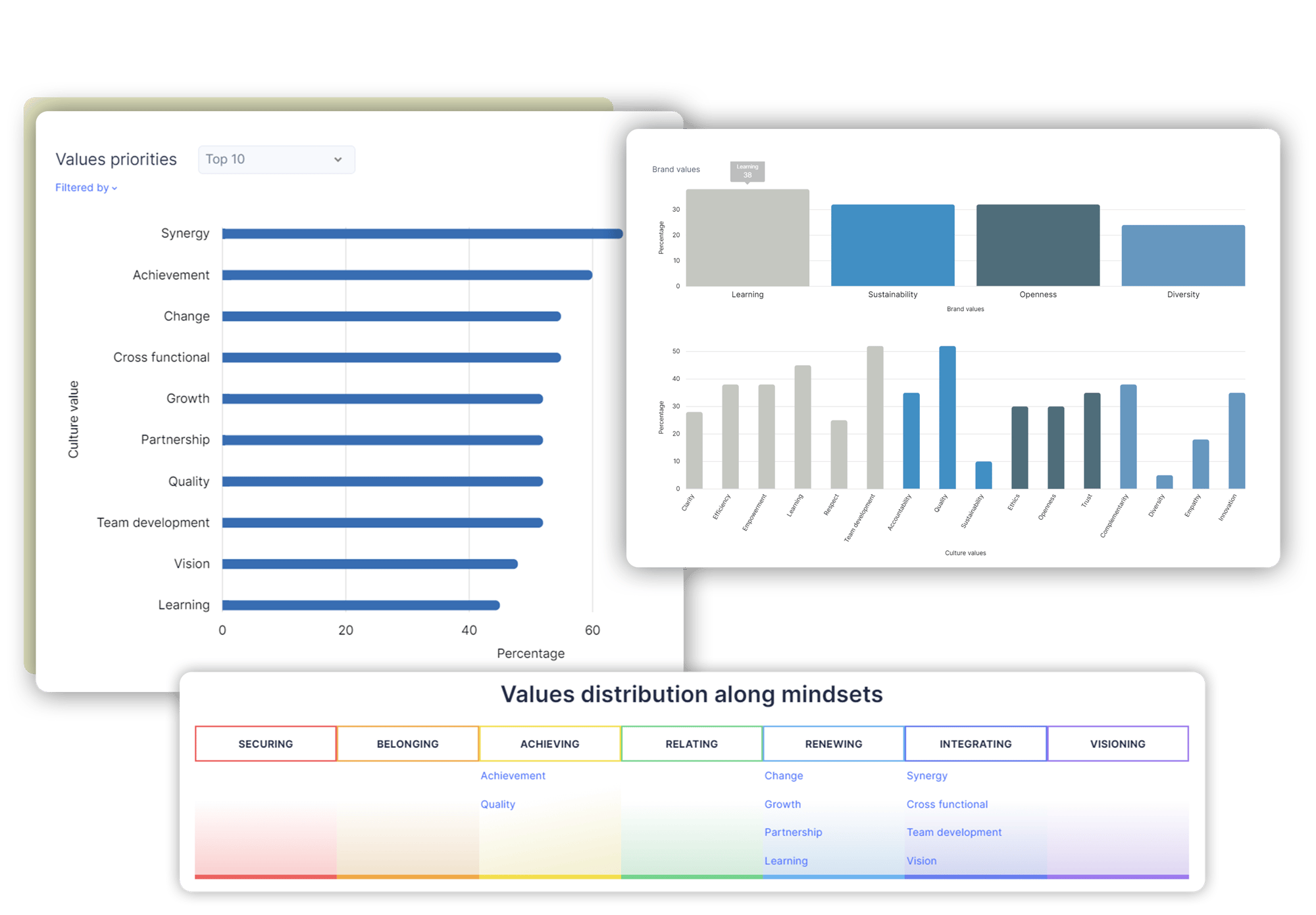
Datadrevet kulturinnsikt for raskere endring
Få objektiv innsikt i verdier for å effektivisere og styrke organisasjonsendring.

Brukt av HR-ledere og kulturansvarlige i selskaper som:















Hvorfor er kultur så viktig for din bedrift?
0%
mener at bedriftskultur er viktigere enn lønn.
Forbes, 2022
0%
av bedrifter planlegger å ta i bruk nye teknologier for arbeidsstyrken innen 2027.
World Economic Forum 2023
0%
av HR-ledere er enige om at deres kultur ikke er der den burde være.
Gartner, 2023
Noen av bruksområdene for kulturdata
Fusjoner og oppkjøp
Rekruttering
Innovasjon
Merkevareidentitet
Psykologisk trygghet
Få innsikt i kulturen i begge selskapene
Analyser de kulturelle aspektene i hver organisasjon og identifiser de unike bidragene de kan tilføre.
Sammenlign verdiprioriteringer
Få en oversikt over verdier og tankesett for å identifisere samsvar og potensielle kulturkonflikter.
Skap en helhetlig kultur
Design den strategiske kulturen for sammenslåingen og definér kulturreisen som sikrer samsvar mellom partene.
Kommuniser den fremtidige kulturkoden
Formidle selskapets verdier og merkevaretrygghet tydelig under rekrutteringsprosessen.
Velg kandidater som passer med kulturkoden
Ansett personer som best samsvarer med selskapets kultur for å sikre en god kulturmatch.
Effektiv onboarding av nye talenter
Identifiser hvilke verdier som må aktiveres for å integrere talenter i teamene på en god måte.
Start med en forhåndsdefinert innovasjonskulturkode
Bruk kulturdata for å analysere elementer i kulturen som fremmer innovasjon og identifisere potensielle hindringer.
Bygg bro over innovasjonsgapet
Visualiser forskjellen mellom dagens og ønsket innovasjonskultur for å identifisere nødvendige tilpasninger.
Tilpass innovasjonsreisen
Juster organisasjonen til innovasjonskulturkoden og aktiver verdiene som er viktige for hver enkelt person.
Utvikle en merkevaretilpasset kulturkode
Skap en dynamisk kulturkode som reflekterer merkevarens verdier og styrer organisasjonen gjennom konkrete handlinger og prinsipper.
Visualiser samsvaret mellom ansatte og merkevaren
Vurder i hvilken grad ansatte og team samsvarer med de ønskede merkeverdiene og merkevareidentiteten.
Få en veiledet strategi for samsvar
Tilby skreddersydd veiledning til ansatte og team for å styrke enhet og fremme atferd som er i tråd med merkevareidentiteten.
Få målbar innsikt i psykologisk trygghet
Kvantifiser verdier som påvirker psykologisk trygghet i stedet for å basere deg på subjektive vurderinger.
Identifiser barrierer og muligheter
Kartlegg kulturen for å finne verdier som enten fremmer eller hemmer psykologisk trygghet, og fremhev sentrale elementer som åpenhet og tillit.
Styrk ledere med en datadrevet tilnærming
Gjør det mulig for ledere å prioritere psykologisk trygghet i organisasjonen gjennom en praktisk og resultatorientert tilnærming.
Culture Intelligence ble løsningen
Metodikken til Culture Intelligence ga oss data, et rammeverk og praktiske verktøy for å forstå vår faktiske kultur. Den ga oss et verdifullt perspektiv for å analysere og identifisere nye nøkkelverdier som situasjonen krevde. Den teknologiske løsningen gjorde det mulig å definere vår fremtidige arbeidsmåte på en datadrevet og presis måte, med både kollektive innsikter og individuell påvirkning for hver leder.
Anne Berit Rørlien, CEO at Viken Fiber
Vi bruker Culture Intelligence for å bygge et solid grunnlag for systematisk og strukturert arbeid basert på fakta. Verktøyet gir rask tilgang til informasjon om mange personer og kan også hente ut data på ulike nivåer i organisasjonen (individ, team, ledergrupper, overordnet). Det gir også muligheter for analyser mot normgrupper og bransjestandarder.
Vibeke Forgaard & Siv Skjæveland Valseth, Co-founders at Unlock Potential

Gjennom applikasjonen har vi lyktes med å implementere en strategisk tilnærming til vår kultur og tilpasse den til vår overordnede strategi. Det er utrolig verdifullt å kunne klikke på en verdi eller tankesett og få detaljerte definisjoner, kontekster og praktiske tips om hvordan vi kan jobbe aktivt med dem. Sammenligning av teamene hjalp oss med å forstå hvordan hvert team i organisasjonen er forskjellige fra hverandre.
Unni Hafskjold Mildon, HR leader at Studentsamskipnaden i Sørøst- Norge
Vårt innholdshub

.png?length=780&name=CC%20-%20Podcast%20-%2079%2016%20(1).png)
84: Kultur som nøkkel i Sykehuspartner, Hanne Tangen Nilsen
